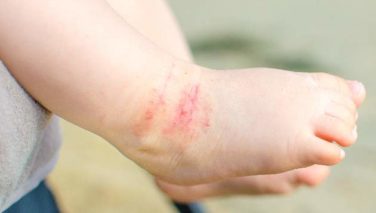AT THE INTERNATIONAL LIVER CONGRESS 2015
VIENNA (FRONTLINE MEDICAL NEWS) – The early results of a prospective, multicenter study show a high rate of hepatic focal lesions, further supporting liver cancer screening in patients with alcoholic liver disease, according to researchers.
The first results from the National Cohort of Uncomplicated Alcoholic Cirrhosis ( CIRRAL ) show that the cumulative incidence of hepatic focal lesions was 10.7% at 1 year and 18.1% at 2 years. The incidence of hepatocellular carcinoma (HCC) was about 1.6% at 1 year and 4.5% at 2 years.
“Primary liver cancer has a high incidence in Europe and in France,” said Dr. Nathalie Ganne of Assistance Publique des Hôpitaux de Paris–Hôpital Jean-Verdier, Bondy, France. “However, the natural history of HCC in alcoholic cirrhosis is not well known,” she said at the meeting sponsored by the European Association for the Study of the Liver.
EASL clinical guidelines recommend screening for hepatocellular carcinoma (HCC) in cirrhotic patients and the association’s general recommendations for screening for complications should be applied to those with alcoholic cirrhosis. However, Dr. Ganne pointed out, there were conflicting data on the value of HCC surveillance in patients with alcoholic liver disease.
On the one hand, data from a large retrospective Danish Registry study involving more than 8,400 patients suggested the risk of HCC was low, at around 0.25%-0.5% per year, so screening was unlikely to save many lives or to be cost-effective ( Ann. Intern. Med. 2012;156:841-7 ). On the other hand, prospective data from a Spanish cohort of 450 patients suggested that there was a relatively high HCC risk, at 2.5% per year, and screening could have a greater impact on mortality ( Clin. Gastroenterol. Hepatol. 2013;11:95-101 ).
To address the controversy and better understand alcoholic liver cirrhosis, the CIRRAL cohort was established with the aim to prospectively describe the natural history of the disease, including documenting the incidence of HCC and other complications, and identifying risk factors or predictors for HCC.
The study population comprised 599 patients with histologically proven, alcohol-related cirrhosis recruited over a 4-year period at 24 centers in France and 2 centers in Belgium. For inclusion, patients needed to have a history of chronic alcohol abuse and compensated liver disease (Child-Pugh A), to be hepatitis B and hepatitis C negative, and to have no prior history of liver cancer. Patients were screened for HCC, liver biopsy samples were obtained, and ethanol breath tests were undertaken at enrollment and annually thereafter.
Most patients were male; the median age was 58.6 years. Almost 70% of patients were abstinent from alcohol, with a median time of 28.4 months since alcohol was consumed. About 17% still had mild alcohol consumption, defined as having one to six alcoholic drinks per week.
Most patients had a history of smoking, with 35% being former and 36% being current smokers. Most patients (78%) were regular coffee drinkers, at an average of two cups per day; almost 40% drank three or more cups per day.
At baseline, 24 (4%) of 548 evaluable patients had a liver nodule, of which 13 were benign hemangiomas or biliary cysts and 11 were undetermined or regenerative nodules. After a median follow-up of 17 months, 13 of these patients still had a liver nodule present, of which two were confirmed as HCC. In the group of 524 patients without a liver nodule at baseline, 60 patients had a liver nodule at follow-up, of which 16 were confirmed as HCC.
“As expected, patients with baseline nodules were more at risk of focal lesions or proven HCC at follow-up,” Dr. Ganne said. The cumulative incidences of hepatic focal lesions and HCC at 2 years’ follow-up were 13.4% and 3.7% in those without and 76.8% and 13.3% in those with liver nodules at baseline.
Because of the short duration of current follow-up, no predictive factors were found, but there was a nonsignificant trend that linked HCC to a long duration of cirrhosis and the persistence of alcohol consumption.
Looking at the characteristics and treatment of the 18 cases of HCC, the researchers noted that 17 met noninvasive criteria. Eight were uninodular, nine were multinodular, and one was infiltrative. Fifteen (55%) met Milan criteria for liver transplantation. Seven cases (38%) received curative treatment involving percutaneous ablation.
Dr. Ganne reported that the overall and event-free survival rates at 2 years were 92.1% and 80.2%. The high rate of hepatic focal lesions found suggests that about 10% of patients per year will need a recall diagnosis procedure, she said.
Also, as the incidence of HCC was greater than 1.5% during the first year and probably an additional 3% per year thereafter, judging by the second year cumulative incidence rate, surveillance for HCC in patients with alcoholic liver cirrhosis “might be cost effective,” she concluded.
The CIRRAL cohort is an ongoing study that will form the backbone for additional studies into HCC in alcoholic liver disease, Dr. Ganne observed. Biological samples are being stored and a prospective database has been set up to include details of all assessments performed. Three nested studies are underway: one is looking at genetics using biobanked material (PANGEN), another is using the database to understand the role of the intestinal microbiota (MACHA), and another is looking at the potential role of nutrition (ALICIR).
The French National Cancer Institute, the French Association for Cancer Research, and the French National Agency for Research on AIDS and Viral Hepatitis funded the study. Dr. Ganne has no conflicts of interest.



